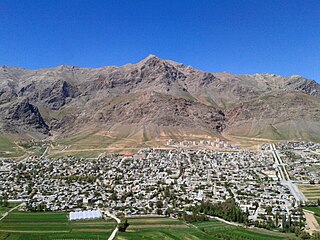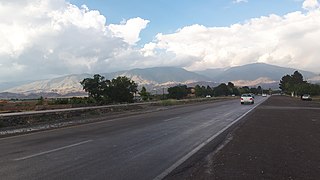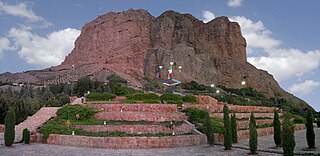Related Research Articles

Fereydunshahr is a city in the Central District of Fereydunshahr County, Isfahan province, Iran, serving as capital of both the county and the district. It is about 150 km west of the city of Isfahan in the western part of the province. With an elevation of about 2500 meters above the sea level, Fereydunshahr is the highest town in Iran.

The Köpet Dag, Kopet Dagh, or Koppeh Dagh, also known as the Turkmen-Khorasan Mountain Range, is a mountain range on the border between Turkmenistan and Iran that extends about 650 kilometres (400 mi) along the border southeast of the Caspian Sea, stretching northwest-southeast from near the Caspian Sea in the northwest to the Harirud River in the southeast. In the southwest it borders on the parallel eastern endings of the Alborz mountains being together part of the much larger Alpide belt. The highest peak of the range in Turkmenistan is the Mount Rizeh, located at the southwest of the capital Ashgabat and stands at 2,940 metres (9,646 ft). The highest Iranian summit is Mount Quchan at 3,191 metres (10,469 ft).

The Karkas mountain chain is a mountain range in central Iran. Having a northwest-southeast direction, it is stretched from Kashan to Ardestan for more than 100 kilometres. With an elevation of 3895 metres, the highest peak of the Karkas Mountains is Mount Karkas which is situated close to Natanz.

Dena is the name for a sub-range within the Zagros Mountains, Iran. Mount Dena, with 80 km (50 mi) length and 15 km (49,000 ft) average width, is situated on the boundary of the Isfahan, Kohgiluyeh and Boyer-Ahmad and Chaharmahal and Bakhtiari Provinces of Iran.

Mount Jahanbin is a 3,200-metre-high (10,500 ft) mountain in Chaharmahal and Bakhtiari Province, central Iran. Jahanbin mount is about 2 km west of the Hafshejan City, 15 km south of Shahrekord and 100 km in south-west of Isfahan. Mount Jahanbin is part of Zagros mountain range which runs along the northwest to southeast of Iran. From the geological point of view Jahanbin mount in made of limestones from the Cretaceous period located in the folded Zagros geological structure.

The Aladagh Mountains or the Aladagh Range refers to a mountain range situated in the southeastern section of Iran's North Khorasan province, southeast of the Caspian Sea. The range is located 25 kilometres south of Bojnurd, the capital city of North Khorasan. The Aladagh Mountains merge with the Elburz or Alborz Mountains in the west and then run southeastwards in a northwest-southeast direction. The highest peak of the range is Mount Shahjahan with an elevation of 3,032 metres. This peak is located about 35 kilometres east of Esfarayen, almost in southeastern part of North Khorasan Province.

The Binalud Mountain Range or the Binalud Range is a mountain range that runs in a northwest-southeast direction between the Nishapur and Mashhad regions in Razavi Khorasan Province in northeastern Iran, to the southeast of the Caspian Sea. Although far from the Aladagh Mountains, which lie to the northwest in the Province of North Khorasan, the Binalud Mountains are located in such a way that both the Aladagh Mountains and the Binalud Range lie approximately in the same arc, curving from the northwest to the southeast. The city of Mashhad is located in the northeastern part of the Binalud Range, and the city of Nishapur or Neyshabur lies on the southwestern section of the range. Situated somewhat to the west of the Binalud Range proper, and with an elevation of 3,211 metres, Mount Binalud is the highest point both of the Binalud Mountains and of Razavi Khorasan Province as a whole.

With an elevation of 3,032 metres, Mount Shahjahan is the highest point in the Aladagh Mountains and North Khorasan Province in the northeastern Iran. This peak is located in the southeastern part of the Aladagh Range. The cities of Faruj and Shirvan are situated in the northeast and the north, respectively, the city of Esfarayen lies to the west, and Bojnurd, the capital of North Khorasan, is to the northwest. Mainly formed in the Miocene and the Pliocene, Mount Shahjahan is made chiefly of Jurassic rocks.
The Bashagard Mountains or the Bashagerd Mountains is a mountain range that is located in southeast of Iran. The mountain range runs in an arc almost in a northwest-southeast direction from eastern parts of Hormozgan Province along the border with Kerman Province and stretching into southern part of Sistan and Baluchestan Province. With an elevation of 2185 metres, Mount Buniken is the highest point of the range located in the western section of the Bashagard Mountains, east of Sardasht in Bashagard County in Hormozgan Province, and in the vicinity of a place that marks the borders of Kerman, Hormozgan, and Sistan and Baluchestan provinces. Made of ophiolite, an assemblage of mafic igneous rocks representing remnants of former oceanic crust, the mountain range was formed finally in the Miocene and the Pliocene during the Alpine orogeny. The mountain range is located in a region with a hot semi-desert climate.
The Jaghatai Mountain Range is located in the western part of Razavi Khorasan Province in northeast Iran. Running in a northwest-southeast direction, the Jaghatai Range stretches from the west and southwest of the town of Jaghatai in the northwest to the northeast and east of the city of Sabzevar in the southeast. With an elevation of 2945 metres, Mount Zar is the highest point of the range. Mount Nazargah is situated in the central part of the range, northwest of the city of Sabzevar. The mountain range is located in a region with a cold semi-desert climate.
Kuhbonan Mountains or Kuhbonan Highlands,, are a group of mountains that are located in the northern part of Kerman Province in Iran. Stretching in a northwest-southeast direction, the mountain range is situated in the northwestern, eastern, and southeastern part of the city of Kerman, northeast of the town of Zarand, and southwest of the town of Ravar. With an elevation of 4233 metres, the highest point of the range is Mount Pelvar or Mount Palvar which is located southeast of the city of Kerman and about 25 kilometres east of the town of Mahan.
Mount Marshenan or Mount Mareshnan is a mountain that is located approximately 60 kilometres north-east of the city of Isfahan and 30 kilometres north of Kuhpayeh. With an elevation of 3330 metres, this mountain is about 15 kilometres south-east of Zefreh and 3 kilometres south of the village of Marshenan in Isfahan Province, almost in central Iran. Made chiefly of Eocene andesite and pyroclastic rocks, Mount Marshenan is situated in a central Iranian range, Sahand-Bazman volcanic range or belt, a mountain range which was formed mainly during Eocene volcanism and that stretches approximately from Sahand volcano in the north-west of Iran to Bazman volcano in the south-east of Iran.

Mount Soffeh or Kuh-e Soffeh is a mountain that is situated just south of the city of Isfahan, southeast of Mount Donbeh and south of the Zayanderud River in Iran.
Mount Kolah Qazi or Kuh-e Kolah Qazi is a mountain that is located about 30 kilometres southeast of the city of Isfahan in Isfahan Province in Iran. With an elevation of 2534 metres, the highest peak is in the north-central part of the mountain. Having a general northwest-southeast direction, this mountain is situated southeast of Mount Shah Kuh and west and almost parallel to Mount Qaruneh. With an average width of about 5 kilometres and a length of almost 20 kilometres, this mountain is a part of the Mount Kolah Qazi Protected Nature Reserve which covers an area of about 50,000 hectares of national park and 3,000 hectares of protected wildlife region.
Mount Qaruneh or Kuh-e Qaruneh is a mountain which is located about 30 kilometres southeast of the city of Isfahan in Isfahan Province in Iran. Situated southeast of Mount Shah Kuh and being almost parallel to Mount Kolah Qazi this mountain has an average width of about 2 kilometres and a length of around 25 kilometres. Mount Qaruneh has a general northwest southeast direction. With an elevation of 2030 metres, the highest peak is located in the southern section of the mountain. Mount Qaruneh is situated in the Sanandaj-Sirjan geologic and structural zone of Iran and is made mainly of Lower Cretaceous limestone.
Shah Kuh or Mount Shah Kuh is a mountain which is located about 15 kilometres south of the city of Isfahan in Isfahan Province in Iran. With an average width of about 3 kilometres and a length of almost 20 kilometres, this mountain has a general northwest-southeast direction and is situated almost northwest of Mount Kolah Qazi. The highest peak is located in the northern section of the mountain and has an elevation of 2418 metres. Mount Shah Kuh is situated in the Sanandaj-Sirjan geologic and structural zone of Iran, and except for a very small section of Jurassic rocks in its north-central part this mountain is mainly formed of Lower Cretaceous limestone.
Shahankuh is a mountain located about 20 kilometres southwest of the city of Fereydunshahr in the western part of Isfahan Province in Iran. With an elevation of 4,040 metres, the Shahankuh is the highest mountain in Isfahan Province. Situated in the Zagros Mountains and stretched in a general northwest-southeast direction and almost parallel to other Zagros mountains, the Shahankuh has an average width of about 3 kilometres and a length of almost 20 kilometres.
Qaflankuh or Qaflankuh Mountain Range is a mountain range that is located about 20 kilometres north of the city of Zanjan in Zanjan Province, Iran. With an average width of almost 20 kilometres and a length of about 100 kilometres, this mountain range is stretched in a northwest–southeast direction, beginning from northwest of Zanjan, passing north of Zanjan and ending southeast of Zanjan. The Qezel Owzan River flows in a valley that separates Qaflankuh Mountains on the south from Talish Mountains on the north. With an elevation of 2971 metres, Mount Sendan Dagh is the highest mountain of the range which is located in the southeast section of this mountain range. There are some mineral hot springs containing sulphur in different parts of this range. Geologically, Qaflankuh Mountain Range was formed during the Tertiary volcanism and plutonism and is made mainly of the Eocene volcanic rocks with very small sections of intrusive rocks in the northern and southern parts of the range.

Hezar Masjed Mountains are a group of mountains that form the southeastern section of the Kopet-Dag Range. Located about 20 kilometres east of Dargaz and 70 kilometres north of Mashhad in Razavi Khorasan Province in Iran and stretched in a northwest-southeast direction, the mountains are situated almost at the extreme northeastern part of Iran.
The Sahand-Bazman Volcanic and Plutonic Belt or the Sahand-Bazman Igneous Arc or the Central Iranian Range is a mountain range that is made by igneous and pyroclastic rocks. Located East and almost parallel to the Zagros Mountains, the Central Iranian Range is stretched in a north-west-southeast direction from Mount Sahand in Azerbaijan in the north-west to Mount Bazman in Baluchistan in the Southeastern part of Iran. This range was mainly formed during the Tertiary volcanic and orogenic phase and especially in the Eocene volcanism and plutonism. The Central Iranian Range or the Sahand-Bazman Volcanic Belt includes famous mountains such as the Sahand in East Azerbaijan Province, Mount Karkas in the Karkas Mountains and Mount Marshenan in Isfahan Province, the Jebal Barez, Mount Hezar and Mount Lalehzar in Kerman Province, and the Bazman in the Sistan va Baluchestan Province of Iran.